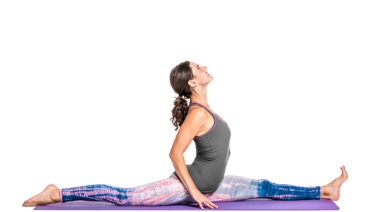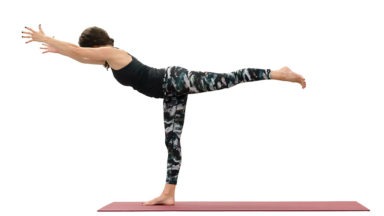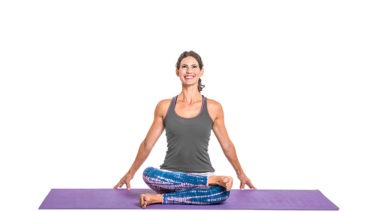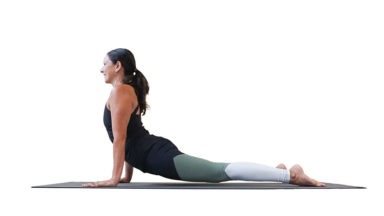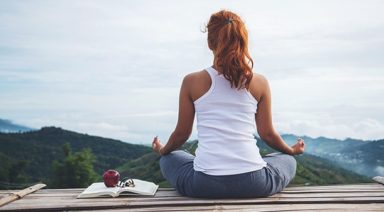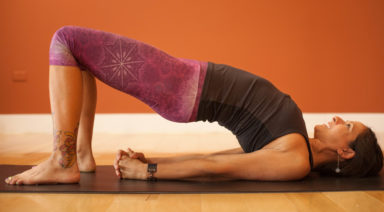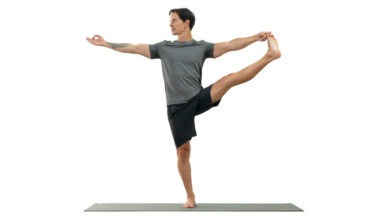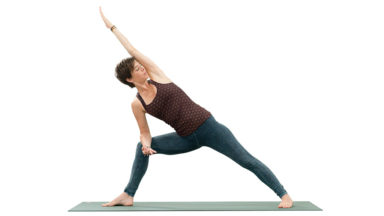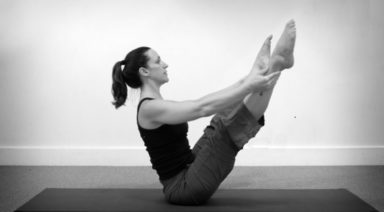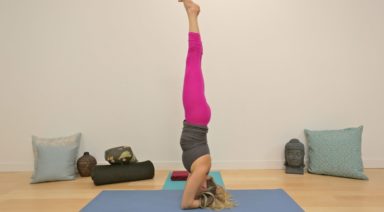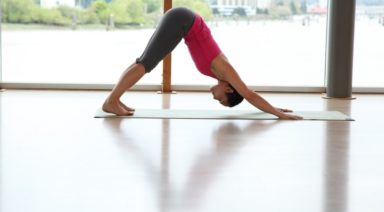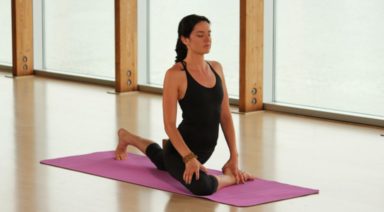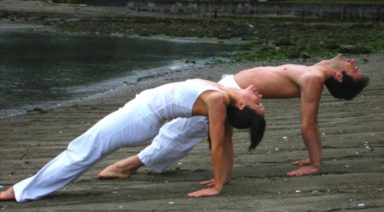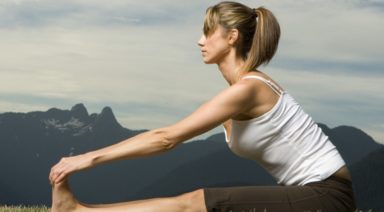Morning Yoga: From Waking to Awakening

In the first breath of the day lies infinite potential, when the senses are barely stirring and before the eyes have opened. In that first breath, the nexus of dreaming and waking, we begin to co-create with the universe. From that breath basis, every subsequent movement, thought and instantaneous decision contributes to the design of what will ultimately become our day.
We may not pay much attention to this moment because the average adult enjoys somewhere between 17,000 and 24,000 breaths per day, but that first one can be especially potent.
The first breath sets the tone and determines the bhava (mood or essence) of the day. With that in mind, I encourage you to allow yourself a “do-over” if you happen to be greeted with either of the two most common thoughts upon waking, “I didn’t get enough sleep” or “I don’t have enough time.”
Close your eyes, welcome a deep breath, and try again.
THE VINYASA OF WAKING
As Shiva Rea describes in Tending the Heart Fire, vinyasa is any sequence that results from an unfolding of consciousness. Consciousness being the operative word as vinyasa denotes an order that is carefully selected, on purpose, in a special way. Morning yoga practice begins before we find our mats, with the vinyasa of waking – the intentional order in which we do things when we emerge from the depths of sleep. What we choose to do with our first waking hours can have a profound impact on how we live the rest of our day.
English theologian Richard Whately once cautioned, “lose an hour in the morning, and you will spend all day looking for it.” While he was certainly onto something of value, I suggest we reframe his message in a more affirmative light: make use of an hour in the morning and you will find there is still a whole day ahead of you. Where the former preys on scarcity mentality and fear, perhaps the latter more effectively illustrates the shift that can occur when you start your morning off in a meaningful, productive way.
CONSULTING THE SUTRAS
In his translation of Yoga Sutra 2.1, Pandit Rajmani Tigunait, spiritual head of the Himalayan Institute, explains, “the schematic practice of yoga consists of three components: tapas, svadhyaya and ishvara pranidhana.”
- Tapas – to heat, purify or transform. Yoga as a physical, disciplined practice using the instrument of the body
- Svadhyaya – the study of the self, through the self, to the self; yoga of inner wisdom and mental energy
- Ishvara Pranidhana – surrender to the infinite, acknowledgement of the divine; yoga as an intimate spiritual practice that transcends the illusion of separation
Using this paramount sutra as a guide, I invite you to consider the benefits of morning yoga, offered below in the context of these three components, and how it can improve physical, mental and spiritual vitality.
HERE COMES THE SUN
So what do circadian rhythm and melatonin have to do with morning yoga? The answer lies in our relationship with the sun. It’s no coincidence that one of the most universally practiced yoga sequences honors the sun with movements that mirror its celestial progression. The various expressions of this Surya Namaskar are an embodied celebration of our intimate connection with the source of light and life, our solar star.
When we practice morning yoga, particularly around sunrise, we attune, in body and breath, to the perceived movement of this radiant light source.
On a cellular level, exposure to morning light initiates the body’s start-up procedure. Upon first exposure to light from darkness, the brain shuts down melatonin production thereby stimulating physical systems and corresponding bodily functions. Unfortunately, our eyes do not distinguish between natural and unnatural light sources, so that middle-of-the-night glance at a smartphone screen to check the time, is like telling your body it’s party time.
When the timing of initial light exposure changes dramatically over a short period of time, for example when we wake up at different times from one day to the next or when we experience jetlag, circadian rhythms can become desynchronized (note: This is different than the gradual shift that occurs with seasonal light changes, which happen slowly at a rate of minutes each day).
Studies have shown that even small disruptions in circadian rhythm occur in a variety of physical diseases suggesting that our health is impacted by the ability to establish a steady sleep schedule. Consequently, by virtue of committing to a consistent time each day, morning yoga can improve the regularity of of sleep patterns and overall physical health.
MUSCLE SET LENGTH
In Dr. Ray Long’s canonical reference book, “The Key Muscles of Yoga,” he describes muscle “set length” as the maximum extension of a muscle, recognized as the limit of a stretch by the brain. In morning yoga practice, using various techniques that safely lengthen and contract muscles with breath-facilitated movement, we reprogram the waking set-length of muscle fibers. With this increased set length, especially in major muscle groups supporting the legs, hips, spine and shoulders, strain on joint surfaces may be reduced and postural alignment improves. This leaves our bodies better equipped to mitigate lifestyle stressors throughout the day, such as driving or sitting at a desk, by establishing a strong baseline of balance and support.

SVADHYAYA: MORNING YOGA TO CLARIFY THE MIND
MOVING MEDITATION: STARTING ANEW
The morning hours are a time of increased mental receptivity when the lines of communication between physicality and intellect remain relatively open. If we can resist the immediate pull toward external stimuli, we may uncover the sweet spot between waking up and awakening. This pivotal place arises before our brains have commandeered our consciousness and left our bodies running on autopilot. In this quiet time, like the day, we are new. This is the time for moving meditation.
DINACHARYA: RITUAL HEALING
Dinacharya refers to daily ritual activities, dina meaning day and charya, to follow with devotion. When initiating a morning yoga practice, resist the urge to let it devolve into another item on your to-do list, let it be an invitation to the infinite potential available in every day. Let it connect you to your highest intentions without needing it to look or feel a certain way. There will be days when your practice is vigorous and energizing, and other days when you find yourself more meditative and still. Rather than imposing a particular style or external form, let your morning ritual grow and chances are it will bring you more joy.
SELF CARE: DIVINE RESPONSIBILITY
Consider your practice as a form of sustenance, the higher the nutritional value the better. If you feel depleted after your sadhana, there will be little left over to carry you through the day. On the other hand, when you are nourished and revitalized on the mat, you are left with a greater reserve of compassion and kindness for those around you. With the myriad responsibilities and relationships that deserve our loving attention on a daily basis, self-practice in the morning guarantees a necessary dose of alone time that may be harder to find as the day progresses.
“Self care is a divine responsibility.”
Danielle LaPorte
ISHVARA PRANIDHANA: MORNING YOGA AS SPIRITUAL SELF CARE
BEGIN YOUR DAY WITH SPIRIT
In the Tao of Physics, Fritjof Capra finds common ground among eastern and western traditions with an etymological examination the word “spirit”. From the latin, spiritus, to Greek, psyche, to Sanskrit, atman, these words can be interpreted as “the life breath.” Collectively, they refer to the one breath breathing us all. It follows that a spiritual experience or more intentionally, a spiritual practice is one that makes us feel alive.
Morning yoga practice is a direct link to our aliveness. With breath as the prime mover guiding physical postures, we connect to our intimate expression of spirit both within and without. Bringing awareness to the breath first thing in the morning will likely improve the way we breathe throughout the day.
CONNECT TO THE COSMOS
Earlier, we looked at circadian rhythm and sun-centered practice from a physical perspective. Now, let’s take a look at the spirit that permeates this devoted tradition. In its purest form, Surya Namaskar, when coupled with breath and focused attention, serves as a moving prayer. A prayer that doesn’t require validation or affiliation, one that is free to take on whatever form serves its orator. One that joins body, mind and spirit in a dance with the divine and plants the seeds for future acts of kindness.
As we undulate between extension and folding of the spine, we embody the cosmos, becoming the rising and the setting sun or the waxing and waning moon. We experience the balance-seeking rhythm of nature in the complementary qualities of inhale and exhale as a progression of internal seasons. Ultimately, we find a deeper connection to ourselves.
“The day is the upward moving exhale and the night is the downward moving inhale.”
Kalottara Tantra XI.9, translated by Christopher Tompkins
SANDHYA KALAS: SACRED JUNCTURES OF TIME
Waking up with the sun leverages perhaps the most influential among four distinct sandhya kalas, sacred junctures of time, throughout the day. Sandhya Kalas occur 20 minutes before and after sunrise, sunset, noon and midnight.
In the practice of morning yoga, we have an opportunity to observe the natural progression of time in the gradual lighting of day which can drop us into the present moment, untethered to past or future.
It is suggested that these pivotal times of transformation allow us to transcend limitations because the environmental energy is in a state of flux. All things are fluid and we are more readily available to the vibration of spanda, the creative pulse of the universe.
SUPPORTED BY LINEAGE
By acknowledging the generous lineage of modern postural yoga, mantra and meditation, we recognize that we are preceded by thousands of years of devoted practice dating back to the Rig Vedas. With deep respect and gratitude, as we offer a morning yoga practice, we begin our day with the unshakeable support of history and tradition.
KICK-START YOUR MORNING YOGA PRACTICE
Now that we’ve addressed the physical, mental, and spiritual qualities of morning yoga practice, I want to leave you with a few practical ways to discover what works for you and your A.M. rhythm.
1. FIND SACRED SPACE
If morning yoga is new to you, you may choose to create your sacred space the night before. If your family dynamics allow, meaning your home practice is not in shared space, carefully lay out your mat, altar, essential oils, props, etc. the night before so you can begin as soon as possible after you wake up.
2. SET AN ALARM
This isn’t new information, but I recommend placing your alarm away from your bed so that silencing it requires at least some degree of movement. You might also consider downloading an app that lets you select your waking soundtrack. My preferred alarm is one that gradually increases to a preset volume to help minimize the jolt of waking up unnaturally.
3. BE GENEROUS WITH YOURSELF
Do you know that you need a few minutes in the morning before your ready to focus and move? Factor in these extra moments so you’re not tempted to trim the time from your practice.
4. DEVELOP YOUR PERSONAL ENERGY METER
Let the practice unfold to meet the unique conditions of each day, check-in with your energy supply and evaluate your whole-body needs before diving into your morning yoga practice. This might be a pose or a gentle mini-sequence that scans your body for any areas needing attention. Balasana (Child’s Pose) and Tadasana (Mountain Pose) are great asanas for gathering this information. Also, variations of kneeling cat/cow or spontaneous supine flow can offer excellent insight. My personal morning yoga ritualalways begins with a super slow, inquisitive round of Surya Namaskar A, staying for several breaths in each posture. I find that particularly in the morning, if I begin lying down, it becomes increasingly more difficult for me to rally the energy I need to sustain the rest of my day. After that first namaskar, I typically know how to set the direction for the rest of my sadhana.
5. KEEP IT SIMPLE
Remain in receptive, twilight mode by limiting complexity at first. If the movement or the sequencing become too complicated, it can over intellectualize the practice. Instead, surrender to the effortless creativity of your instinctual body and try not to let the mind get too involved. It will likely see enough action during the remainder of your day.
6. MOVE FROM LOVE
Above all else, let love be the place you move from.
“All yoga practice is described as a means to loosen the knot in the heart.”
Shiva Rea
5 Kundalini Morning Rituals That Will Change Your Life

I found myself asking again and again, what is this and how have I not known about these practices before?
Although my Vinyasa practice continues to be steady, for the past year, I have changed up my morning routine to include several new Kundalini morning rituals. These rituals don’t just make me feel great, but I am not exaggerating when I say that they have really changed my life. The bouts of depression and anxiety I used to experience, especially postpartum, have disappeared. Not only do I feel brighter and more radiant, but my mind is clearer. I’m more even-tempered. I see more. And I’m experiencing more success than ever.
Here are the five most powerful Kundalini morning rituals I do regularly, daily if possible. Although you’ll feel results immediately, it takes thirty to forty days of consistent practice to really start changing your life. And, believe me, it will change your life.
- Cold Showers: Although it was one of the hardest rituals to get used to, cold showers are now part of my daily routine. I start with dry brushing and then coat my body in coconut oil. Then I get under the cold water, allowing it to hit my face and chest. I’ve found that you can massage your body, from the soles of your feet to your shoulders and neck, to help keep you warm (and to give you something to do). Even just thirty seconds under the cold water will change everything. And, according to Guru Jagat, cold showers are one of the best practices for glandular health, anti-aging, increased energy, and mental alertness. They will also improve the condition of your skin – you really do “glow” afterward!
- Subagh Kriya: This powerful sequence takes about twenty minutes from start to finish. It is said to be an incredibly effective way to bring more abundance and prosperity to your life. The whole sequence is done seated and involves various hand movements and chanting. You can find videos of this sequence to follow along with online at first, but after a few times doing it, you’ll learn how to do it yourself. The impact this has had on my professional life is astounding. I never start my day without doing this practice.
- Breath of Fire: This is one of the most powerful practices I do. Designed to reset your glands and hormones, this pranayama technique brings your entire body back into balance. Although it is sometimes taught with only an emphasis on the exhale, in Kundalini, the emphasis is equal on both the inhalation and exhalation. It is a powerful, rapid breath through the nose, but it is sustainable. Most Kundalini teachers recommend you practice breath of fire for at least seven minutes to reap the most benefits.
- Sat Kriya: One of the most essential practices in the Kundalini technology system, Sat Kriya is a simple breath meditation that helps to energize your body and increase your radiance. To practice it, sit on your heels, bringing your arms overhead. Interlace your fingers and release the index finger, squeezing the palms together. As you pull your navel in powerfully, you mentally chant “Sat.” As you exhale and release the belly, you repeat, “Nam.” Just three minutes of this kriya can elevate your awareness and energy. I do this practice in the morning, but also throughout the day when I feel like I need a boost. If I need more after the first three minutes, I’ll keep adding more three-minute rounds until I feel ready to take on whatever is next in my day.
- Frog Pose: This simple exercise is a lot harder than it looks, which is why I love to do it in the morning – it makes me sweat! To begin, you start in a squat position with the knees wide and the heels up. As you exhale, you come to stand, looking towards your thighs. As you inhale, you look forward and return to the frog squat. You can go as fast or as slow as you like. I’ll do at least 26 of these each morning, although many times I’ll go for three or more minutes. Although your legs might shake, keep going! The energy that will flood your body when you’re done is amazing. And I’ve found it’s a great way to shift my mood quickly, too.
While much of Kundalini yoga will feel strange at first, especially if you are used to different styles of yoga, I’ve learned to love it. Not only are the results of Kundalini morning rituals astounding, but almost everything is accessible, which means I don’t have to “feel” like doing yoga to do it. And, because the practices are fast, there’s no excuse to add them to your morning routine!









